Podcast: Play in new window | Download (Duration: 26:55 — 29.8MB)
Subscribe: Apple Podcasts | Google Podcasts | Spotify | Amazon Music | Android | Pandora | iHeartRadio | JioSaavn | Podcast Index | Email | TuneIn | RSS | More
This part will cover additional stories found through deeper research, adding to the history shared in found in the new book, Grand Canyon Rim to Rim History. Grand Canyon rim to rim hikes and runs become very popular as thousands descend into the Canyon each year. Fastest known times for R2R and R2R2R runs are broken.
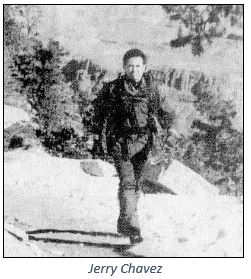

In 1991, Jerry Chavez, a Vietnam veteran of Leadville, Colorado, worked for the NPS. He operated the pump station at Indian Garden, which pumped water up to the South Rim. He lived year-round at a nice residence down at Indian Garden. Chavez was also a member of the park’s 20-member rescue team and kept in shape by running rim-to-rim.
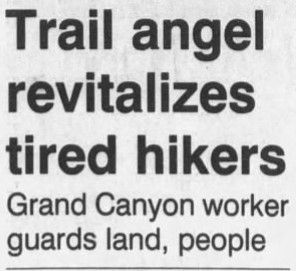

Chavez said that the “dumbest thing” he saw was people hiking without food or water. “Chavez had seen a lot of weird things in the Canyon, including a guy hiking in a dusty tuxedo and women in high-heel shoes.” Often, he would rescue hikers suffering from heatstroke. One recent case was particularly bad. He remembered, “When I saw that man, he looked like death. We had to carry him up a mile. His temperature was 109. We were running water from a creek and kept pouring it on him. When they flew him to Flagstaff, he still had a temperature of 105. The doctor called and said whoever worked on him saved his life. The guy walked out of the hospital as normal as can be.” Chavez was awarded a National Park Service achievement award.
Out-of-shape parents were often seen bringing down small children. On a winter day in 1989, Chavez was out for a run and found parents with two small children and heavy packs. “The kids were lying in the snow and crying. I told them, ‘You’re going to have to carry those kids out.’” He offered to help, but the father refused and yelled at the kids about 2-3 years old. Finally, Chavez got permission to rescue the kids and carry them out.
Amphitheater High School Double Cross
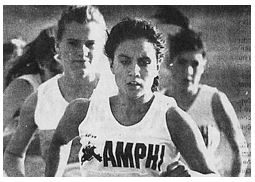

President Bush on South Kaibab Trail


On September 18, 1991, South Kaibab Trail was totally shut down with federal agents crawling around it with rifles and large binoculars. President George H. W. Bush (1924-2018), visited the Canyon and descended down the trail with a group that included Interior Secretary Manuel Lujan (1928-2019). The president wore loafers that became coated with dust and sweat drenched the back of his shirt. He chatted quite a bit about the views and the fishing in the Colorado River and at Phantom Ranch. He really wanted to get to the bottom, but they turned around after going down 685 feet to Ooh Ahh Point. After they turned around, Bush left most of his group behind and powered up the trail. His hike lasted about an hour and covered 1.8 miles.
Major Destruction of the Kaibab Trail in 1992
During February 1992, a major rockslide destroyed a large portion of the North Kaibab Trail between Supai Tunnel and the bridge across the ravine below. It took out nearly 9,000 feet of switchbacks. The slopes had been soaked by early winter rains, became very muddy, and then crashed down into the canyon. Bruce Aiken at Roaring Springs reported, “Rebuilding the trail is going to be very difficult. It will take at least two months, maybe longer.” Hikers were given directions to use the Old Bright Angel Creek Trail instead. “A few hikers have been using this old trail each year, but there has not been enough traffic to keep it well-defined. In some places, it has disappeared.” The closure of North Kaibab lasted for about four months. About 1,500 feet of trail, five switchbacks, and 8,000 feet of retaining wall were destroyed. Tons of fill were used to reconstruct the trail and 25 new drainage devices were put into place.
Also, there was deep concern about an unstable limestone cliff 40x20x10 feet above switchbacks near the trailhead at Yaki Point. The damage was caused by some small earthquakes and heavy rain over the winter. The south trail was closed for about a month for repairs. “The work included blasting the unstable formation and reconstructing 1,300 linear feet of the trail. About 600 tons of debris caused by the blasting was removed.”
1992 Flash Flood at Cottonwood Campground
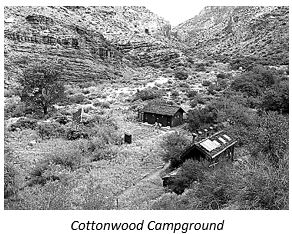

Wisher then helped several people stranded on a picnic table to get through the water to safety. Once they all got in dry clothes and made hot food, Wisher went to check the upper campground. He had to wade across a 35-foot channel of 2-3 feet of flowing water to get someone out of their tent and bring them to safety. Finally, all 28 campers were accounted for and in the station. “Not only did he feed and shelter for all of the campers, supplying emergency food and clothing of his own, but he also comforted several campers suffering from hysteria.”
For his bravery and quick heroic action, he was given a “Valor Award” by Department of Interior Secretary, Bruce Babbit (1938-) in a ceremony held in Washington D.C.
Rim to Rim Bras


In 1993, an artist, Ronald Gary Nicolino (1939-2009) of Point Richmond, California, had a unique idea for a rim-to-rim. He wanted to string 10,000 bras across the Grand Canyon in 1995 and planned to ride Amtrak coast to coast to collect donated bras. He said, “Every bra is like a vote.” The National Park, of course, said it wouldn’t happen. Nicolino said, “We have to be awfully careful with the engineering. There has to be zero impact. We don’t want brassieres floating down the walls into the Colorado River. The chain will move with the Canyon breeze, emitting a rich, soft glow and a slight hum. It will bring joy to all those who view it.”
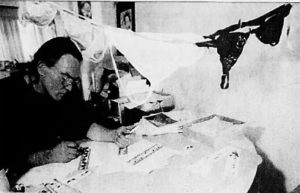

Donations came in. Radio stations held promotions collecting bras. He had his distracters. One man wrote him, calling him a “creepy degenerate pervert.” Nicolino did travel by train, getting donations for his “Bras Across the Grand Canyon” project, waving his donations at stops.
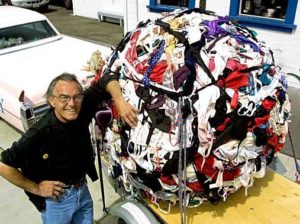

By July 1994, he had 2,000. By 1996, the project was put on the back burner. “Nicolino wants to take the 10,000 bras he’s collected and string them between two high-rises across Madison Avenue in New York.” Eventually, with 14,000 donated bras, he created a “Big Giant Bra Ball” like a rubber band ball and pulled it around with a pink Cadillac. Nicolino died of cancer in 2009, at the age of 69.
Rim to Rim Run by Iowans
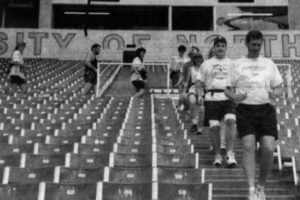

David Anderson Whitsett (1942-), age 53, of Cedar Falls, Iowa, a professor of psychology at the University of Northern Iowa, and a veteran of two rim-to-rim runs, publicized and organized a rim-to-rim run for Iowans. Assisted by Lynn Allen, a fitness instructor, a large group showed interest. This October 1994 event demonstrated the new popularity of running across the Canyon.
Whitsett said, “We found 27 wackos who want to do it. They range all the way from triathlons to people who have never done anything like this before.” Organized training began in June, six days a week for those who intended to run. The run took place, but no details were published. Whitsett went on to co-author The Non-Runner’s Marathon Trainer in 1998.
Rim-to-Rim Group Organizer Arrested
A group rim-to-rim event did not go as well for Carl Johnson, age 50, who advertised his event in High Sierra Magazine. He collected fees and told participants how to enter the park by a reduced fee, claiming they were part of “one big family.” When park officials contacted Johnson before the run, he said he was just getting a few friends together and it was not an organized event, needing a permit. But the Park Service was smarter. An employee signed up for the run to prove it was an organized event.
Twenty-eight people took part in the October 9, 1995, run. Johnson was arrested that day and pleaded guilty in U.S. Magistrate Court. He was fined $500, and the park confiscated the event T-shirts. Criminal investigator for the park, Franco Sidoti said, “In the case of Mr. Johnson, they said one thing but were doing another. I’m sure they didn’t realize the potential consequences. We go out of our way to educate and give people a chance to understand our rules.”
Group Double Crossing Run
Groups were also being organized to run double crossings. On December 6, 1994, a group of seven from Flagstaff, Arizona, all in their 40s and 50s, started their double crossing at the South Rim. They were led by Richard Haag, age 54, a dentist and veteran of seven previous R2R2Rs. He said, “The first year it started out as just to see if we could do it. Every time you run it, you swear you’ll never do it again. But then in a day or two after, you start to think about how great it was, and you end up doing it again.” Running down for more than an hour, one runner realized he had forgotten his water. He turned around, went up, headed down again, and caught up with the group at Phantom Ranch. Most of them made it, finishing at 8:30 p.m., although a few turned around before reaching the North Rim.
The National Park personnel noticed the article published in a Flagstaff newspaper about this run, upsetting Beverly Perry, the backcountry ranger. She said, “Running rim to rim is becoming a status symbol. Articles romanticizing this kind of thing only make matters worse. People are naïve. Bad things happen here, especially to runners.” She was concerned about stretching the resources of search-and-rescue teams, as well as endangerment of the runners and other people using the trail. Haag countered, “Their concern about us running is the same as about any hiker. We could get in no more or less trouble than a hiker. We were not organized. We did not give awards. We did not charge fees. Is it against the law to go over a walker’s pace? No.”
1995 Washout Closed Trails – No Rim-to-Rim Hiking
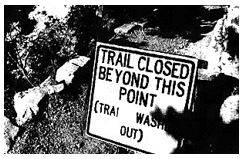

In late August Bright Angel Trail had to be closed for two weeks because of more flash floods that washed away a two-mile stretch of trail, “and scattered rock and debris across most of the path.” Twenty-five sections of the trail needed to be restored. The park spokesman said, “We know we’ll get some people not happy about this, but this is geology in action. We hope people understand when they come to a natural park, Mother Nature rules.” After being closed for nearly seven months, the full North Kaibab Trail was finally opened again on October 1, 1995.
Swim Instead of Hike
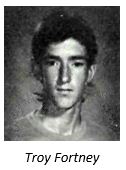

Budget Cuts Threaten Rim to Rim
In 1995, during the Clinton presidency, the Republican Congress was slashing its budget, including a 10% cut for national parks. Grand Canyon National Park needed to consider how to cut back on its costs. Among the proposed changes was to close the inner canyon for day hiking below the Tonto Platform, from June to the end of October, which would halt rim-to-rim hikes and runs for nearly half of the year. This was not implemented.
Attempted Rim to Rim on Bikes
![]()
![]()
70-Year-Old Runs Rim to Rim and Back
In October 1996, Marge Withrow, age 70, an experienced 50K ultrarunner from Lompoc, California, sought to show that a woman of her age could run across the Grand Canyon and back. She reported, “On day one, we ran from the South Rim to the North Rim in 8:30. The temperature ranged from 60 to 62 degrees.” With three friends, the next day they returned using Bright Angel Trail, finishing in nine hours. Three years later, she summited 14,496-foot Mount Whitney in California, on her 73rd birthday.
1997 Flash Flood Kills Two
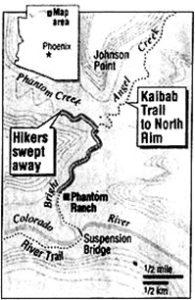

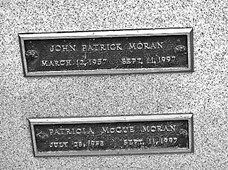

1999 Flash Flood Injures Hikers


Fred Fox, age 26, of Las Vegas, Nevada, and some of his buddies were camped at the Bright Angel Campground across from Phantom Ranch. He said, “About 3 a.m., we woke up to what we thought was thunder. Pretty soon, we realized it wasn’t thunder at all, but boulders being rolled down Bright Angel Creek. The creek was way over its edges, so we got up and broke camp. We ended up spending the rest of the night in the tunnel on the South Kaibab Trail, just over the Black Bridge. There were logs, and I mean big logs like trees, in the Colorado River this morning.” North Kaibab Trail was again ravaged, and 2,000 feet of the pipeline was exposed. About 300 feet of electric cable was also exposed in Pipe Creek. North Kaibab Trail was closed for two months.
Proposal to Restrict Rim-to-Rim Hiking


In 1999, the park continued to wrestle with the challenge of having so many people hiking or running rim to rim. During 1997, nearly 500 search or rescue missions took place. “In response to the ever-growing number of people who wish to test themselves against the rigors of the Canyon, the Park Service is instituting a new permit system in an attempt to educate those contemplating such a trip. The problem is that too many people underestimate the Canyon or overestimate themselves and end up in trouble.” The system proposed would require a $20 permit for any extended day hike rim-to-rim or rim-to-river-to-rim. “Only 200 persons each would be permitted to make a long-distance day hike and no permits would be issued for competitive or commercial events.” The permit policy was not implemented.
Fastest Known Time Single-Crossing
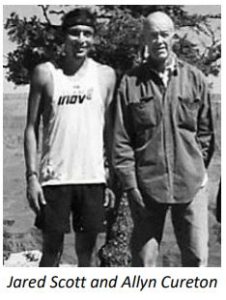

Fastest Known Time Double-Crossing
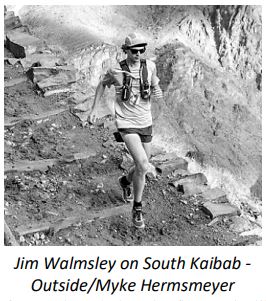

Among the women, as of 2022, Taylor Nowlin (1991-) of Colorado, holds the double-crossing FKT with 7:25:58, set on November 11, 2021.
Beyond the Double Crossing
In 1987, Wally Shiel of Arizona accomplished the first quad crossing in 24:45. Jim Nelson (1961-2014), of Salt Lake City, Utah, lowered the fastest known quad time in 1999 to 22:48:00. The author accomplished the quad in 2006, the fifth to do so, and added more miles to make it an even 100 miles. In 2022, Jeff Browning (1971-), of Flagstaff, broke the quad FKT with 17:55:14, which was supported (pacers and aid). As of 2022, less than 20 people had accomplished a quad.
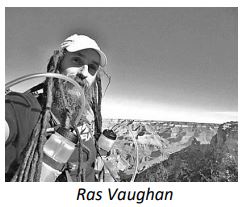

In 2018, Christof Teuscher (1972-) also accomplished the sextuple-crossing, while being live-tracked on the internet with a Spot device. He finished in one day, 17:18:00.
Two Quad Crossings
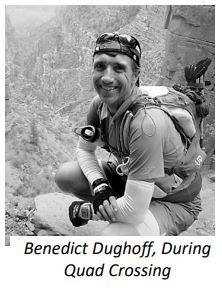

The Decuple Crossing
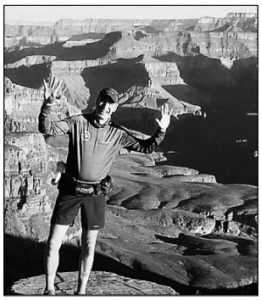

He recalled a funny experience, “A lady stopped me in the bottom of the Canyon, and she said, ‘I keep seeing these guys running by themselves wearing the same green shirt you’re wearing.’ She wanted to know what the shirt was all about and what all of the runners were doing. I told her, ‘No, that’s just me you’ve been seeing. I just keep going back and forth.’”
Hooge completed his decuple crossing on May 24th, 2021, for a time of four days, 17:22:46, for a distance of about 226 miles with 58,000 feet climbing along the way.
A few months later, in September 2021, Brandon Worthington (1985-), of Colorado, also accomplished the decuple crossing, doing it faster, in three days, 21:51:06, without the outside support of crew or pacers.
Gerd Nunner – 100 Crossings
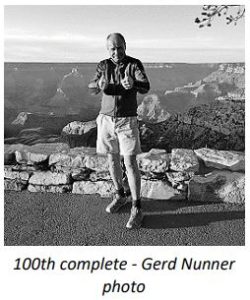

Nunner made his first hike down into the Canyon in 2000, accomplished 18 rim-to-river-and-backs, and in November 2003, did his first rim-to-rim when he was 51 years old. He then set an original goal of reaching 50 trips across the Canyon. But as his passion for the experience increased, so did his goal. “Nunner grew up in Würzburg, in southern Germany, and climbed the Alps and Dolomites in his teens. Hiking became a part of his life, so when he moved to the United States in 1990, the lure of trails in the American Southwest gripped him.” Nunner admitted, “I’m an addicted hiker. You don’t have to be the Olympian with the gold medal to do this. You can do this and be the average Joe.” All his hikes were accomplished in less than 18 hours, with his fastest in 14:30.
Sharing the Trail with Others
Attempts to break Fastest Known Times or personal bests, continued over the years, at times infuriating hikers and backpackers when runners would pass by with selfish rudeness, making people stop for them. It created constant friction.
In 2014, ESPN published an article about runners in the Canyon and quests for FKTs. “There are no broad statistics on the number of runners who do R2R or R2R2R runs. Everyone agrees that the number is increasing.”
I was quoted in the article: “When I started, only a handful of pretty fit and experienced runners were doing the canyon runs. Now the word’s getting out and as more of these articles are being read, more casual runners are attempting this and making a lot of mistakes. I’ve heard rangers are concerned that people are treating it like Disneyland.”
Another 2014 article stated, “In their desperation and delirium, they cut to the front of water lines, clog trails and picnic areas by lying down, and leave things behind them. Rangers and more experienced visitors have to attend to struggling crossers.”
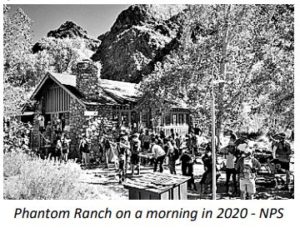

On Saturday, October 10, 2020, during the pandemic, Grand Canyon NPS tweeted a warning that they counted 430 people in four hours during the morning at Phantom Ranch. “Be prepared to encounter lots of people. For more solitude, plan your crossing on a weekday.”
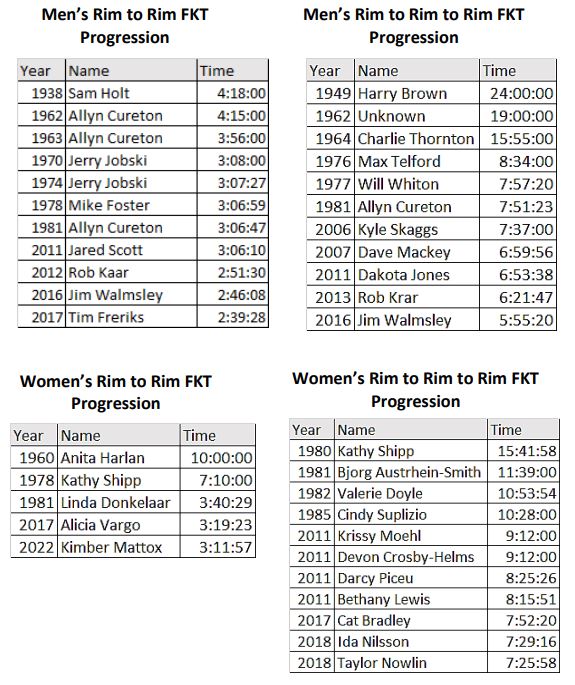

Grand Canyon Rim-to-Rim Series
- 46: Part 1 (1890-1928)
- 47: Part 2 (1928-1964)
- 48: Part 3 (1964-1972)
- 49: Part 4: Aiken Family
- 50: Part 5: The Races
- 135: Part 6: Early Guides
- 136: Part 7: Prof Cureton
- 137: Part 8: Kolb Brothers
- 138: Part 9: Phantom Ranch
- 139: Part 10: More on 1927-1949
- 141: Part 11: More on 1950-1964
- 143: Part 12: More on 1971-1989
- 144: Part 13: More on 1990-2020
Sources:
- Arizona Daily Sun (Flagstaff, Arizona), Jan 15, 1995
- Richmond Times-Dispatch (Virginia), Feb 10, 1991
- The Times-News (Twin Falls, Idaho), Nov 16, 1993
- The Courier Journal (Louisville, Kentucky), Jan 2, 1994
- The Philadelphia Inquirer (Pennsylvania), Mar 12, 1994
- Southern Utah News (Kanab, Utah), June 23, 1992, Dec 7, 1994, Jan 3, 1996
- The Courier (Waterloo, Iowa), Oct 4, 1994
- The Lompoc Record (California), Oct 14, 1996
- The Daily Chronicle (De Kalb, Illinois), Sep 17, 1997
- Washington Post, June 23, 1999


